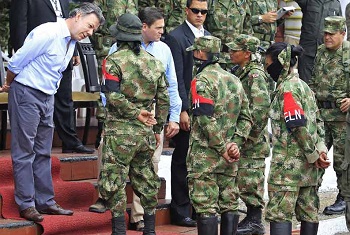Rebels from Colombia’s second-largest guerrilla group have been demobilizing from the insurgency at nearly double last year’s rate, adding weight to concerns that the guerrilla leadership is incapable of controlling its troops — a factor that will likely hinder attempts to negotiate peace with the government.
The Colombian Army has registered a 92 percent rise in the number of National Liberation Army (Ejército de Liberación Nacional – ELN) guerrilla troops who have demobilized or surrendered this year, according to an official report accessed by RCN Radio. This total increased from 119 in 2015 to 229 in 2016, going against a downward trend in overall demobilizations in Colombia over the past decade.
The number of ELN guerrillas killed in combat also increased 54 percent from 424 in 2015 to 653 this year, while the number of those arrested rose 48 percent from 256 to 380 so far in 2016. Also this year, the Colombian army thwarted 45 percent more attacks on infrastructure such as oil pipelines and roads, and seized 112 percent more explosive artifacts.
Statistics showed a 24 percent decrease in the number of military officials killed in 2016, to 24.
InSight Crime Analysis
The rise in demobilizations offers more evidence of the ELN’s fragmentation and lack of discipline within its ranks, as the group struggles to unite its forces behind a peace negotiation with the Colombian government.
Official talks with the ELN were set to begin in October 2016, but these plans were derailed by the ELN’s failure to release hostage Odín Sánchez, a former congressman. The government has since postponed any discussion surrounding talks with the ELN to January 2017, citing the “ELN’s request to conduct an internal consultation,” which some believe will address the Sánchez issue.
SEE ALSO: Coverage of ELN Peace
The ELN’s mixed messages regarding the high-profile hostage situation have unveiled deep fissures within the organization, and suggests that the top commanders are not in control of their troops. The Cimarrón Resistance Front (Frente Resistencia Cimarrón) in Chocó department, which is the one holding Sánchez, is reportedly at odds with the Central Command (COCE) and could represent a breakaway faction. In October this year, 24 members of Cimarrón Resistance, including the second in command, collectively demobilized from the front.
The concerns about the ELN’s lack of unity have been exacerbated by the continued belligerence of ELN factions despite attempts to work towards peace. Many of the attacks have been on the Venezuelan border, including in the department of Arauca, where the ELN’s richest and most powerful unit, the Eastern War Front, operates. This bloc is led by a wild card among the ELN leadership — Gustavo Aníbal Giraldo Quinchía, alias “Pablito” — who may further destabilize peace efforts if he does not adopt a supportive stance.
SEE ALSO: Coverage of FARC Peace
Another worry is that divisions within the ELN could benefit dissident members of the FARC guerrilla organization, which has just finalized a peace agreement with the Colombian government and is awaiting judicial guarantees before demobilizing. But up to half of all rebels may break away from the process and while this stalls, reports are already emerging of guerrilla fighters across the country deserting the insurgency. Some of these could choose to join ELN units — something that is already occurring in certain areas — strengthening the ELN’s military force and criminal economies in the process.

